Mahan Air Airline, Arrival at Tehran Airport
- W5082 (International) - Kuala lumpur / Tehran
Departure: 23:15
Arrival: 02:45 (+1)
- W51089 Tehran / Shiraz
Departure: 09:30
Arrival: 10:50
- W5083 (International) - Tehran / Kuala lumpur
Departure: 21:30
Arrival: 10:00 (+1)
Day 1: Tehran/Kuala Lumpur (Departure)
Assemble at KLIA 3 hours to departure. Depart at 23:15 to Tehran by Mahan Air
Day 2: Tehran/Shiraz (Arrival – 1hr20min Flight)
Meet and greet at the IKA airport with our professional tour guide then, transfer to IBIS Hotel which is located next to IKA Airport, to pray and have breakfast then, pick-up and transfer to Mehrabad Airport for a domestic flight to Shiraz. After check in Hotel then you can visit:
THR- SYZ Domestic flight AM at 09:30
- Eram Garden
Eram Garden is a historic Persian garden in Shiraz, Iran. It belonged to the leaders of Qashqai tribe before being confiscated by the central government. The garden, and the building within it, are located at the northern shore of the Khoshk River in the Fars province.
- Vakil Bazaar and Hammam
Vakil Bazaar after many years’ stills almost healthy and well that it’s one of the Iran attractive place is one of most famous traditional and historical Iran bazars. All the internal and external trades was being done at this bazar, somehow was Palpitating heart of Shiraz economic. The architect of this structure is contained of stories by wide bench and has 74 upward glottis and high height Vault that these skilfully made. Bathroom is place near bazar and Vakil mosque at Shiraz city centre. The amazing part of this structure is predominantly for king place. The Technology that it used in heating and cooling system is amazing that it caused had least waste energy, as the simple floor cover by stones and under the stones has many Corridors which are made very hot by-passing steams as soon as you think! In the part of bathroom wall painted about interesting and dreams of people, traditional and religion
- Karim Khan Citadel
The Karim Khan Castle is a citadel located in the downtown Shiraz, southern Iran. It was built as part of a complex during the Zand dynasty and is named after Karim Khan, and served as his living quarters. In shape it resembles a medieval fortress.
- Hafez Tomb
The Tomb of Hafez and its associated memorial hall, the Hāfezieh are two memorial structures erected in the northern edge of Shiraz, Iran, in memory of the celebrated Persian poet Hafez. The open pavilion structures are situated in the Musalla Gardens on the north bank of a seasonal river and house the marble tomb of Hafez. The present buildings, built in 1935 and designed by the French architect and archaeologist André Godard, are at the site of previous structures, the best-known of which was built in 1773. The tomb, its gardens, and the surrounding memorials to other great figures are a focus of tourism in Shiraz.
O/N Shiraz Day 3: Shiraz - Isfahan
After Breakfast transfer for Half Day sightseeing of Shiraz then Transfer to Isfahan in Route Visiting;
- Pink Mosque
it is also called the “Mosque of colours,” the “Rainbow Mosque” or the “Kaleidoscope Mosque”. This is a space where light and worship intertwine. The mosque comes to life with the sunrise and colours dance throughout the day like whirling dervishes. It reflects on the ground, walls, the arches and the towering spires. It even reflects on the visitors as if a colourful ball is hit by the first sun ray and explodes to thousands of butterflies all around.
- Quran Gate
Qur'an Gate is a historic gate in the north of Shiraz, Iran. It is located at the north-eastern entrance of the city, on the way to Marvdasht and Isfahan, between Baba Kouhi and Chehel Maqam Mountains near Allah-O-Akbar Gorge.
- Persepolis
Persepolis was the ceremonial capital of the Achaemenes Empire. It is situated 60 km northeast of the city of Shiraz in Fars Province, Iran. The earliest remains of Persepolis date back to 515 BC. It exemplifies the Achaemenes style of architecture.
- Necropolis
A necropolis is a large, designed cemetery with elaborate tomb monuments. The name stems from the Ancient Greek νεκρόπολις Necropolis, literally meaning "city of the dead".
- Pasargadae
Pasargadae was the capital of the Achaemenes Empire under Cyrus the Great who had issued its construction; it was also the location of his tomb.
Upon arrival in Isfahan visiting;
- Si – o - se Pol Bridge
: The Allahverdi Khan Bridge, popularly known as Si-o-se-pol (the bridge of thirty-three spans), is the largest of the eleven historical bridges on the Zayanderud, the largest river of the Iranian Plateau, in Isfahan. Si-o-se-pol was built between 1599 and 1602, under the reign of Abbas I, the fifth Safavid king (shah) of Iran. The bridge served particularly as a connection between the mansions of the elite, as well as a link to the city's vital Armenian neighbourhood of New Julfa. (Lunch or Dinner in Abbasi Restaurant)
- Khajoo Bridge
After 17th Century, travellers visiting Iran and tourist admiration has increased. Shah Abbas II, built new bridge on foundation of old bridge which was constructed in 1650 or so. The bridge serves as a link between Zoroastrian quarters and north banks, through the river Zayandeh River. The bridge is constructed with multi-purpose, the bridge is not only used for transportation but also as weir. (Lunch or Dinner in Niavaran Fast food Restaurant).
O/N Isfahan  Khajoo Bridge
Khajoo Bridge 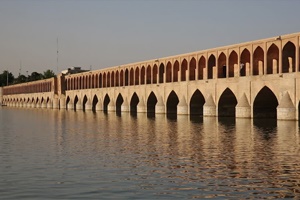 Sio se pol Bridge
Sio se pol BridgeDay 4: Isfahan
After breakfast transfer for full day visiting Isfahan;
- Chehel sotoun palace
Chehel Sotoun is a pavilion in the middle of a park at the far end of a long pool, in Isfahan, Iran, built by Shah Abbas II to be used for his entertainment and receptions
- Masjed Jameh
The Jāmeh Mosque of Isfahān is the grand, congregational mosque (Jāmeh) of Isfahān city, within Isfahān Province, Iran. The mosque is the result of continual construction, reconstruction, additions and renovations on the site from around 771 to the end of the 20th century. The Grand Bazaar of Isfahan can be found towards the southwest wing of the mosque. It has been a UNESCO World Heritage Site since 2012.
- Naqsh-e Jahan square
Naqsh-e Jahan Square, is a square situated at the centre of Isfahan city, Iran. Constructed between 1598 and 1629, it is now an important historical site, and one of UNESCO's World Heritage Sites. It is 160 metres wide by 560 metres long.
- Imam Mosque
The Shah Mosque, also known as Royal Mosque or Imam Mosque after Iranian revolution, is a mosque in Isfahan, Iran, standing in south side of Naghsh-e Jahan Square. Built during the Safavid Empire, ordered by Abbas I of Persia.
- Aali Qapoo Palace
Built at the very end of the 16th century as a residence for Shah Abbas I, this six-storey palace also served as a monumental gateway to the royal palaces that lay in the parklands beyond (Ali Qapu means ‘Gate of Ali’). Named after Abbas ’hero, the Imam Ali, it was built to make an impression, and at six storeys and 38m tall, with its impressive elevated terrace featuring 18 slender columns, it dominates one side of Naqsh-e Jahan (Imam) Sq.
- Sheikh Lotf Allah Mosque
Sheikh Lotfollah Mosque is one of the architectural masterpieces of Iranian architecture that was built during the Safavid Empire, standing on the eastern side of Naghsh-e Jahan Square, Esfahan.
- Bazaar
Esfahan's great market known as Gheisarieh Bazaar is in the northern side of Naghshe jahansquare. Foundation of this great market goes back to Shah Abbas Safavi I era and its masterful architecture belongs to Ali Akbar Esfahani. Various branches of this bazaar are allocated to different professions and businesses. Main parts of the GHEISARIEH BAZAAR include shops, arcades, warehouses, caravanserais and passageways.
O/N Isfahan Day 5: Isfahan – Matin Abad
Drive to Matin Abad, on the way visiting:
- Abyaneh Village
: Abyaneh, also known as the Red Village because of its red soil and houses, is an ancient Iranian Village located at the foot of Karkas Mountain, 70 kilometers southeast of Kashan in Isfahan province. Abyaneh is a Village of living traditions, architectural styles (all in red clay) and probably one of the most interesting examples of human adaptation to nature. The houses bear an ancient architectural style, featured using clay as the construction material and latticed windows and wooden doors.
- Matin Abad
Matin Abad Eco- Resort & Organic Farm, Iran is one of 18 best practices in sustainable (Eco) tourism initiated by governments, NGOs, and private sectors, in developing countries, including SIDS, with potentials for replication elsewhere. The best practices were collected and analyzed by four main criteria: Conservation, Community, Culture, and Commerce, initiated by The Zeitz Foundation, the main pillars of sustainable (eco) tourism. Matin Abad Eco- Resort & Organic Farm was established in 2008.
O/N Matin Abad Eco Camp Day 6: Matin Abad - Qazvin
After breakfast transfer to Qazvin, in route visit the sightseeing of Kashan;
- Fin’s garden
An oasis of lush vegetation can be found in an arid region of Iran. The Fin Garden is regarded as one of the most beautiful gardens of its type, and it has been reported that this is the oldest surviving Persian garden in Iran. Reflecting its location and sacred symbolism, the Fin Garden is a masterpiece combining natural and man-made elements. Today, the Fin Garden is one of the nine gardens that form the UNESCO World Heritage Site known as the ‘Persian Garden’.
- Broujerdiha House
The Borujerdi House is a historic house museum in Kashan, Iran. It was built in 1857 by architect Ustad Ali Maryam for the bride of Borujerdi, a wealthy merchant. The bride came from the affluent Tabātabāei family, for whom the architect had built the nearby Tabātabāei House several years earlier.
O/N Qazvin Day 7: Qazvin – Alamut Castle – Fuman
Early in the morning drive to Alamut Castle for having breakfast in a village near the Castle, after visiting castle, transfer to Fuman city
- Alamut Castle
Alamut is a ruined mountain fortress located in Alamut region in the South Caspian province of Gilan near the Rudbar region in Iran, approximately 100 km (60 mi) from present-day Tehran. In 1090 AD, Alamut Castle was seized as a mountain fortress under the leadership of Hasan-i Sabbah, and until 1256 it was the site of intense activity for the Shi'a Nizari Ismai'lis, functioning as the headquarters of their state, which consisted of a series of unconnected strategic strongholds scattered throughout Persia and Syria, with each stronghold being surrounded by huge swathes of hostile territory.
O/N Fuman Day 8: Fuman - Ramsar
After breakfast drive to visit Masouleh Village, then transfer to Ramsar
- Masouleh Village
Masouleh is a village in the Sardar-e Jangal District, in Fuman County, Gilan Province, Iran. At the 2006 census, its population was 554 individuals from 180 families. Historical names for the city include Māsalar and Khortāb. It was founded in the 10th century AD. Masuleh is approximately 60 km southwest of Rasht and 32 km west of Fuman. The village is 1,050 meters above sea level in the Alborz (or Elburz) mountain range, near the southern coast of the Caspian Sea. The village itself has a difference in elevation of 100 meters.
Upon arrival ramsar go for half day sightseeing;
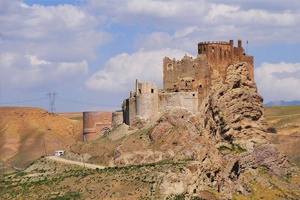 Alamut Castle
Alamut Castle 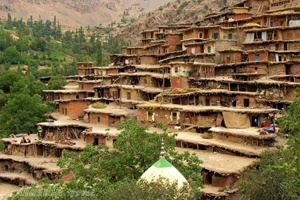 Masouleh
Masouleh - Ramsar Telecabin
creating jobs and planning for sustained development was started in 2004.The difficulty of constructing the upper station of Telecabin on a height of 700 m of an unreachable peak was overcome by powerful hands of the Iranian, and ultimately the Telecabin of Ramsar was operated in May 2008.
Mar Mar Palace The Ramsar Palace was established on a land of 60,000 square meters in 1937. The area was a historical garden in Ramsar. The palace was used as a summer residence by Reza Shah and then by his son, Mohammad Reza Pahlavi. Mohammad Reza Pahlavi and his second spouse Sorayya Esfendiari spent their honeymoon in the palace.
O/N Ramsar 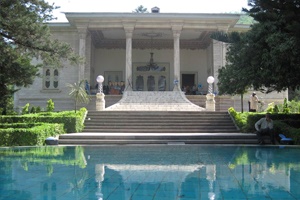 Mar Mar palace
Mar Mar palace 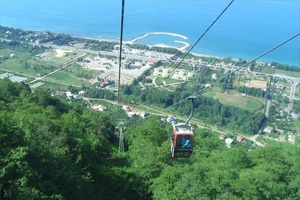 Tele cabin Ramsar
Tele cabin RamsarDay 9: Ramsar – Dizin
After breakfast transfer to Dizin ski Resort
- Dizin Resort
Dizin is the largest Iranian ski resort. It is in the Alborz mountain range, about 70km North from Tehran. It was established during the 1960s under the reign of Mohammad Reza Pahlavi. Dizin is the first ski and winter sport resort in Iran which has been officially recognized and granted the title by the International Ski Federation for its capability in administrating official and international competitions.
O/N Dizin Day 10: Dizin – Tehran (IKA)
After breakfast transfer to Tehran visit some sightseeing in Tehran, then transfer to IKA (Imam Khomeini Airport)
- Golestan palace
One of the oldest historic monuments in the city of Tehran, and of world heritage status, the Golestan Palace belongs to a group of royal buildings that were once enclosed within the mud-thatched walls of Tehran's Arg ("citadel"). It consists of gardens, royal buildings, and collections of Iranian crafts and European presents from the 18th and 19th centuries.
- Imamzadeh saleh
Imamzadeh Saleh is one of many imamzadeh mosques in Iran. The mosque is located at Tajrish Square in Tehran's northern Shemiran district. The mosque entombs the remains of Saleh, a son of the Twelver Shia Imam, Musa al-Kadhim, and is one of the most popular Shia shrines in northern Tehran.
- Tajrish bazar
The Tajrish neighbourhood is located along the northern edge of Tehran. This neighbourhood is one of the oldest parts of Tehran and during the last few decades, has become popular with the wealthy by virtue of the low levels of pollution, in turn created by the area's favorable location along Tehran's northern hills. Tajrish is situated in the Shemiranat County. As of 2006, the neighborhood had 86,000 inhabitants.
In the evening the group will transfer to IKA Airport to fly back home. Day 11: Kuala Lumpur (Arrival)
Landing on Kuala Lumpur International Airport at 10:20am with sweet memories.
ACCOMODATION | City | Hotel | Night |
| Shiraz | Bein Al Haramein 4* hotel | 1 |
| Isfahan | Aliqapu 4* Hotel | 2 |
| Matin abad | Matin Abad Eco Camp | 1 |
| Qazvin | Iranian 4* hotel | 1 |
| Fouman | Moeen 5* Hotel | 1 |
| Ramsar | Parsian 4* Hotel | 1 |
| Dizin | Tourist inn 3* Hotel | 1 |